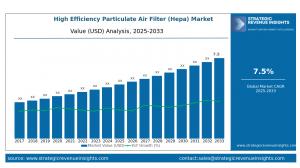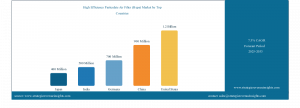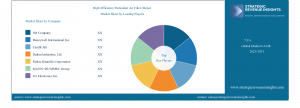High Efficiency Particulate Air (HEPA) Filter Market Set to Reach $6.8 Billion by 2033
HEPA market: $3.5B (2024) to $6.8B (2033), 7.5% CAGR. Growth driven by air quality awareness, regulations, and rising demand in health/auto/industrial sectors.
LONDON, UNITED KINGDOM, UNITED KINGDOM, November 18, 2025 /EINPresswire.com/ -- Strategic Revenue Insights Inc. – The High Efficiency Particulate Air (HEPA) Filter Market is entering a decisive growth phase as air quality, health security, and regulatory scrutiny converge to push demand across residential, commercial, industrial, healthcare, and automotive environments. Valued at $3.5 billion in 2024, the market is projected to reach $6.8 billion by 2033, registering a CAGR of 7.5% over 2025–2033. This trajectory reflects a structural shift: clean air is no longer a discretionary comfort but a core requirement for public health, regulatory compliance, and business continuity. A detailed analysis of this transformation is available in the full High Efficiency Particulate Air Filter (Hepa) Market report athttps://www.strategicrevenueinsights.com/industry/high-efficiency-particulate-air-filter-hepa-market.
At the heart of this growth lies rising awareness about the health impacts of airborne pollutants, fine particulates, allergens, and pathogens. Urbanization, industrialization, and recurring air quality crises in major cities have pushed HEPA filters from niche technical components to mainstream solutions embedded in consumer products, building systems, and critical infrastructure.
Evolving Market Trends: From Niche Technology to Everyday Necessity
The HEPA filter market is undergoing a clear transition from limited, specialized use to broad-based deployment across multiple segments. In residential environments, consumers are increasingly purchasing air purifiers and HVAC systems with HEPA-grade filtration as a direct response to smog episodes, allergy concerns, and heightened awareness of indoor air quality.
Commercial buildings, hotels, airports, retail complexes, and offices are moving from basic filtration to high-performance clean air strategies to enhance occupant comfort, improve productivity, and meet tightening building and occupational health standards. In parallel, healthcare facilities—already long-time users of HEPA technology—are scaling up usage across operating rooms, isolation wards, intensive care units, and diagnostic labs to strengthen infection control.
Industrial settings represent another powerful driver. Manufacturing facilities, pharmaceuticals, food and beverage plants, and electronics cleanrooms are relying on HEPA filters to stabilize production quality, protect sensitive processes, and comply with environmental and worker safety regulations. The automotive sector is adding a new layer of growth, as HEPA-based cabin filtration becomes a selling point for vehicle OEMs targeting health-conscious consumers.
Across all these sectors, buyers are no longer merely asking for filtration; they want verified performance, certifications, and the ability to integrate filters into broader smart building and environmental monitoring strategies.
Technological Advancements: Materials, Design, and Smart Integration
The current generation of HEPA filters is very different from their early predecessors. Advances in materials, fiber geometry, and manufacturing have yielded filters that are more efficient, less energy-intensive, and longer-lasting.
Standard HEPA filters remain the workhorse of the market, capable of capturing very fine particles with high efficiency. However, innovation is accelerating in adjacent product types:
• Activated carbon HEPA filters combine particulate capture with adsorption of odors, VOCs, and gaseous pollutants, making them well-suited for urban, industrial, and automotive environments where air quality challenges are complex.
• Antimicrobial HEPA filters incorporate coatings or fibers designed to inhibit microbial growth on the filter surface, addressing contamination and hygiene concerns in hospitals, cleanrooms, laboratories, and high-risk industrial settings.
Nanofiber-based media, advanced nonwovens, and hybrid filter constructions are enabling higher capture efficiency at lower pressure drops, improving energy performance and enabling more compact system designs. This matters significantly in HVAC applications and vehicles, where air flow and energy consumption are tightly constrained.
On top of the physical media, the market is seeing rapid growth in IoT-enabled filtration systems. Smart purifiers and building systems now use sensors to monitor particulate levels, VOC concentration, humidity, and other parameters in real time. These systems can automatically adjust fan speeds, alert maintenance teams when filters reach end-of-life, and feed data into building management systems or cloud platforms for trend analysis.
This fusion of HEPA filtration with data, automation, and connectivity is transforming filters from passive components into active nodes in broader air quality and environmental management networks.
Sustainability and Cost Challenges: Balancing Performance and Responsibility
Despite strong demand, the HEPA market faces several structural headwinds. One is cost: high initial investment and ongoing maintenance expenses can be a barrier, especially in price-sensitive residential segments and small businesses. HEPA filters typically require more frequent replacement than lower-grade filters, and their higher resistance can increase energy consumption if systems are not optimized.
Another concern is environmental sustainability. HEPA filters are often made from synthetic materials and are not easily recyclable due to contamination and composite construction. As deployment scales up, disposal of used filters is becoming a non-trivial issue, especially in healthcare and industrial contexts where they may be classified as hazardous or infectious waste.
Manufacturers are beginning to respond with:
• Longer-life media and designs to reduce replacement frequency.
• Efforts to optimize pressure drop and improve energy efficiency.
• Research into more sustainable materials and end-of-life strategies.
However, the tension between higher performance, lower lifecycle cost, and environmental responsibility remains a central challenge.
In addition, the HEPA market does not operate in a vacuum. Competing technologies such as electrostatic precipitators, UV-based systems, and advanced activated carbon solutions offer alternatives that, in some use cases, can meet customer needs at lower cost or with different performance trade-offs. This competition puts pressure on HEPA manufacturers to differentiate on reliability, certification, smart capabilities, and total cost of ownership rather than filtration alone.
Market Analysis: Structure, Segmentation, and Competitive Landscape
From a structural perspective, the High Efficiency Particulate Air Filter (Hepa) Market is moderately fragmented, combining global multinationals and strong regional specialists.
By type, the market is segmented into:
• Standard HEPA
• Activated carbon HEPA
• Antimicrobial HEPA
Standard HEPA filters dominate volume, particularly in residential and commercial systems, while activated carbon and antimicrobial variants are growing faster in industrial, healthcare, and high-end residential segments.
By application, demand is spread across:
• Residential
• Commercial
• Industrial
• Healthcare
• Automotive
Residential and commercial markets have historically led, driven by consumer awareness and building standards. However, industrial and healthcare segments are gaining share as regulations tighten and infection control becomes more central to risk management.
By distribution channel, the market is split between offline (retailers, distributors, OEMs, project-based sales) and online (e-commerce, direct digital channels). While offline still accounts for a large portion of high-value deals and system integrations, online channels are scaling quickly—especially for residential purifiers, replacement filters, and small commercial units.
Geographically, the market is defined by a dual dynamic:
• North America and Europe are mature but innovation-heavy, driven by stringent air quality and occupational safety regulations.
• Asia Pacific, particularly China and India, is the growth engine, as rapid urbanization and pollution issues push governments, businesses, and households towards higher-grade filtration.
On the competitive front, major players include:
• 3M Company – leveraging strong R&D, brand, and diversified industrial footprint.
• Honeywell International Inc. – providing integrated air quality solutions across residential, commercial, and industrial environments.
• Camfil AB – a specialist in high-performance filtration for critical environments, including hospitals and cleanrooms.
• Daikin Industries, Ltd. – integrating HEPA filters into HVAC and air conditioning platforms with a global footprint.
• Parker Hannifin Corporation, MANN+HUMMEL Group, LG Electronics Inc., and others – expanding portfolios with performance-focused and energy-efficient air filtration solutions.
Alongside these leaders, a growing cohort of regional manufacturers, especially in Asia Pacific, is competing aggressively on cost while gradually moving up the value chain with differentiated products.
Future Outlook: Smart, Regulated, and Health-Centric Growth
Looking ahead to 2033, the HEPA filter market is expected to become even more deeply embedded in policy, infrastructure, and consumer priorities.
Regulators are likely to tighten standards on indoor air quality in workplaces, public buildings, transportation hubs, and healthcare facilities. As air pollutants, allergens, and pathogen transmission continue to be recognized as systemic public health risks, HEPA-grade filtration will increasingly be written into codes and compliance frameworks.
On the technology side, three shifts stand out:
1. Smart, connected filtration – Filters will be part of integrated building and city-level environmental monitoring systems, with predictive maintenance, automated performance tuning, and real-time health dashboards.
2. Advanced materials and hybrid systems – Expect continued innovation in nanofibers, antimicrobial coatings, and combinations of HEPA with UV, electrostatic, or catalytic technologies to deliver higher performance with lower energy consumption.
3. Embedded filtration in mobility and micro-environments – From vehicles and trains to personal air purifiers and wearables, HEPA-grade or near-HEPA filtration will expand into smaller, mobile, and personal protection applications.
Emerging markets will remain central to volume growth, while mature markets will lead in premiumization, regulation-driven upgrades, and smart system integration. For new entrants, the opportunity lies not only in manufacturing filters but also in solutions and services—designing, installing, maintaining, and optimizing air quality systems tailored to specific industries and environments.
HEPA Filters as a Strategic Lever for Health, Compliance, and Resilience
The High Efficiency Particulate Air Filter (HEPA) Market is no longer a peripheral component market. It has become a strategic enabler of public health, regulatory compliance, industrial quality, and business resilience. With market size expected to nearly double from $3.5 billion in 2024 to $6.8 billion by 2033, HEPA filters are set to play a critical role in how societies respond to pollution, pandemics, and the broader challenge of creating safer, healthier built environments.
For manufacturers, solution providers, and investors, this market offers a blend of steady structural growth, technology-driven differentiation, and expanding application scope. For policymakers and institutions, HEPA technology provides a proven, scalable toolkit for improving air quality and protecting populations.
Stakeholders seeking deeper quantitative insights, competitive intelligence, and forward-looking scenario analysis can access the full suite of research and related market reports at https://www.strategicrevenueinsights.com
Browse the associated report:
https://www.strategicrevenueinsights.com/es/industry/high-efficiency-particulate-air-filter-hepa-market
https://www.strategicrevenueinsights.com/ja/industry/high-efficiency-particulate-air-filter-hepa-market
https://www.strategicrevenueinsights.com/kr/industry/high-efficiency-particulate-air-filter-hepa-market
https://www.strategicrevenueinsights.com/fr/industry/high-efficiency-particulate-air-filter-hepa-market
https://www.strategicrevenueinsights.com/de/industry/high-efficiency-particulate-air-filter-hepa-market
https://www.strategicrevenueinsights.com/it/industry/high-efficiency-particulate-air-filter-hepa-market
https://www.strategicrevenueinsights.com/da/industry/high-efficiency-particulate-air-filter-hepa-market
https://www.strategicrevenueinsights.com/pt/industry/high-efficiency-particulate-air-filter-hepa-market
Related Reports:
https://www.strategicrevenueinsights.com/industry/automatic-high-beam-control-market
https://www.strategicrevenueinsights.com/industry/automatic-high-speed-folder-gluers-market
https://www.strategicrevenueinsights.com/industry/automatic-high-rack-stackers-market
https://www.strategicrevenueinsights.com/industry/alloy-steel-high-pressure-boiler-tube-market
https://www.strategicrevenueinsights.com/industry/automotive-off-highway-engine-market
https://www.strategicrevenueinsights.com/industry/airborne-high-frequency-radio-market
https://www.strategicrevenueinsights.com/industry/ball-screws-for-high-load-drive-market
https://www.strategicrevenueinsights.com/industry/airport-high-loader-market
About Us:
Strategic Revenue Insights Inc., a subsidiary of SRI Consulting Group Ltd, empowers organizations worldwide with data-driven market intelligence. Headquartered in London, United Kingdom, we deliver syndicated research reports, tailored consulting solutions, and actionable insights that equip clients to make confident, future-focused strategic decisions.
Our team of seasoned analysts—based in London and connected globally—continuously tracks markets, identifies emerging trends, and uncovers growth opportunities to support long-term client success. As part of SRI Consulting Group Ltd, we are committed to accuracy, clarity, and practical relevance, helping businesses navigate competitive landscapes, optimize strategies, and accelerate revenue growth.
By combining rigorous research methodologies with deep industry expertise, Strategic Revenue Insights Inc. provides organizations with a comprehensive market perspective that drives measurable results and sustained competitive advantage.
Media Contact:
Company Name: Strategic Revenue Insights Inc.
Contact Person: Ashwani
Email: sales@strategicrevenueinsights.com
Phone: +44 7877403352
Address: Suite10 Capital House 61 Amhurst Road, E8 1LL
City: London
State: London
Country: United Kingdom
Website: www.strategicrevenueinsights.com
Rohit Bhisey
Strategic Revenue Insights Inc.
+44 7877403352
email us here
Visit us on social media:
LinkedIn
Facebook
YouTube
X
Other
Legal Disclaimer:
EIN Presswire provides this news content "as is" without warranty of any kind. We do not accept any responsibility or liability for the accuracy, content, images, videos, licenses, completeness, legality, or reliability of the information contained in this article. If you have any complaints or copyright issues related to this article, kindly contact the author above.





